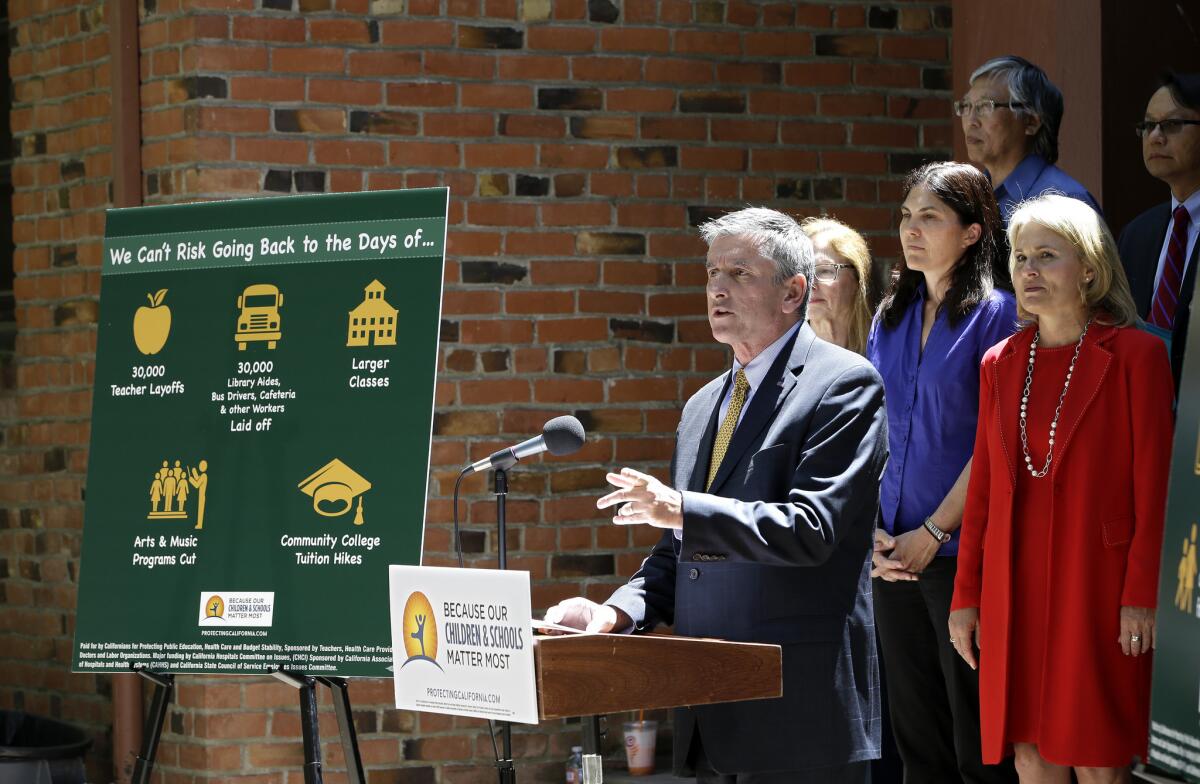Independent expenditures 101: An introduction to outside spending in state races

Eric Heins, president of the California Teachers Association, answers questions concerning a proposed ballot initiative asking voters to extend a temporary income tax increase on the wealthy, at a news conference May 11 in Sacramento. Independent expenditures are coming in from education advocates who want to serve as a counterweight to the influence of the association, a union that’s been one of the most powerful forces in state politics.
- Share via
It’s often said that California is ahead of the curve when it comes to American politics, whether it’s environmental regulations or demographic diversity.
The same could be said for unlimited political spending. While super PACs are a relative newcomer on the national scene, California has seen deep-pocketed outside groups spending top dollar on state campaigns for years.
Here’s a guide to independent expenditures, why we’re seeing so many of them this year and what it means for California’s Legislature.
What are independent expenditures and when did they start to play a big role?
When a donor wants to influence a campaign, they can give money directly to a candidate. But voters limited direct contributions in 2000 with Proposition 34, and the cap grows only with inflation. (It was $3,000 when the law was passed, and $4,200 today.)
So rich people, unions and corporations have increasingly put their money into outside groups, which are not allowed to coordinate with candidates but can spend unlimited amounts of money. Independent expenditures on state legislative races increased exponentially from 2000 to 2010, when the U.S. Supreme Court opened the floodgates to super PAC money in federal campaigns.
How much money are we talking about this year?
Analysts at Target Book, a nonpartisan publication that tracks California politics, expect independent expenditures to crack $25 million before the primary on June 7. That’s a big jump from $16.7 million two years ago.
Why is there more money now than before?
A few reasons. California recently adopted a new system where the top two candidates from the primary advance to the general election regardless of political party. Because Democrats dominate state politics, some business groups have swung their support behind that party’s candidates, not Republicans, to serve as a check on liberals in the Capitol.
One of the most complex issues is climate change, where Democrats don’t always see eye to eye with each other. Last year moderate Democrats blocked legislation that would have cut the use of oil for transportation in half by 2030. Now oil companies want to bolster their standing in the Capitol, while environmentalists like billionaire Tom Steyer want to stop them.
There’s also big money coming from education advocates who want to serve as a counterweight to the influence of the California Teachers Assn., a union that’s been one of the most powerful forces in state politics. Issues like loosening teacher tenure rules and changing the distribution of school money have been divisive among lawmakers.
How is this money being used?
The next time you see a television advertisement, or get a flier in the mail, check the fine print. Even if it’s supporting or opposing a particular candidate, it may not be paid for by that candidate or their opponent. It should say the name of the organization that is footing the bill. If you want to learn more about where the money is coming from, go to Cal-Access, a state website where you can look up a group’s donors.
Twitter: @chrismegerian
More to Read
Get the L.A. Times Politics newsletter
Deeply reported insights into legislation, politics and policy from Sacramento, Washington and beyond. In your inbox twice per week.
You may occasionally receive promotional content from the Los Angeles Times.











